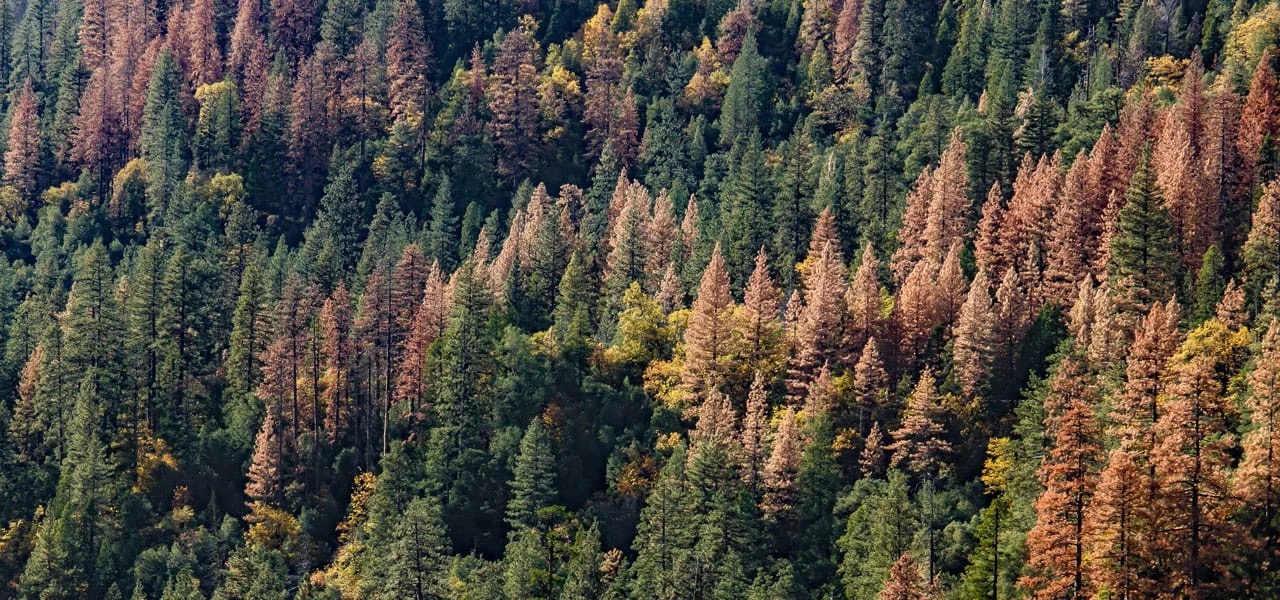Do your shrubs or trees ever show signs of salt damage in the spring? On evergreens, this can appear as the browning of needles, on leafy plants it manifests as burnt or singed-looking leaves.
The Problem(s) With Road Salt
Drought Makes Salt Damage Worse

Road shoulder with heavy salt accumulation
With the drought conditions that we’ve suffered from lately, salt can make the situation even worse. Salt absorbs all of the water around it (think of salt in a salt shaker and how difficult it is to get out if the salt gets wet), and causes dehydration for any plants or trees that have roots nearby. This is a concern during years with normal rainfall, so it is especially worrisome during years where the rainfall is scarce.
Salt Causes Burns
Salt isn’t exactly great for animals, the environment, or us either. If you have pets or kids that play in the snow, watch for burns from the ice melt or salt product used on roadways or sidewalks. Even adults have been burned from sitting or kneeling on salt-covered walkways once the product seeps through clothing.
Deadly For Pets
For pets, ice melt products can be fatal. Watch that your dog doesn’t drink from puddles or eat snow that could be tainted with ice melt products, and either buy dog boots or wash off your dog’s paws once you return inside. Dogs will often lick the salt off their paws and ingest it that way – just a small amount can be deadly.
Negative Effect on Wildlife
Salt can negatively affect wildlife too – read this article from the Smithsonian on the hidden dangers of road salt to see how salt can attract wildlife, which can lead to more road collisions with animals like moose and deer. Studies are also being done to determine if salt affects the size of fish after the melting snow (and accompanying road salt) runs into rivers and lakes. In some cases, “road salt can reduce the size of rainbow trout hatchlings by about 30 percent” and can kill some smaller forms of aquatic life.
However, snow and ice during the winter months are a constant here in Colorado, so what can you do to help your trees and plants survive the road salt assault?
The Possible Solutions to Avoiding Salt Damage
Reducing or eliminating the use of road salt or other ice melt products is the ultimate goal. Most people apply much more salt than is needed, which just makes the problem worse.
Here are some suggestions:
Protect Yourself & Your Pets
- Use an indoor/outdoor mat, carpet, or runner over the icy spots on your sidewalk. You can reuse them as often as needed, and some even come in fun color choices!
- There are pet-friendly versions of ice melt available that usually use some form of urea, which turns into fertilizer. While it is a better option, using too much can still cause issues.
Use Salt Alternatives
- 1/8” gravel is great for adding traction, and you can often sweep it up and reuse it.
- Other options for preventing slips are sand or non-clumping kitty litter.
- Some people suggest using a propane wand (carefully!) to melt ice on walkways and paths.
- A city in Montreal is testing the use of wood chips in place of salt or ice melt products.
Use Salt and Ice Melt Products Properly
- Ice melt products have no effect on light, fluffy snow, so don’t waste the product trying to melt that kind of snow.
- Shovel snow before applying salt to walkways, or pre-apply it before the snow falls.
- You can dilute ice melt products with hot water and spray the liquid on the surface you’re trying to protect. Some products also have a liquid version. Both options allow you to use less product while getting an even better result.
Protect Plants From Salt
- Protect your plants close to roads and walkways with burlap or a plastic fence so they won’t be sprayed with salt (or salty water as the ice or snow melts).
- Shovel salt-contaminated snow away from plants and don’t pile snowbanks near plants that are sensitive to salt.
- As soon as the snow has melted, dilute any salt in the soil near your shrubs or trees by flushing with large amounts of water.
If your plants and trees are still suffering from the effects of rock salt (you won’t be able to tell until the spring), consider replacing them with more salt-tolerant varieties. According to the Colorado State University Extension Office, “there … appears to be a correlation between a plant’s salt tolerance and natural fire resistance,” which can further help you in making your landscape more firewise.
Any of the trees listed as “SA” in this handout from the CSU Extension Office are considered salt tolerant.



